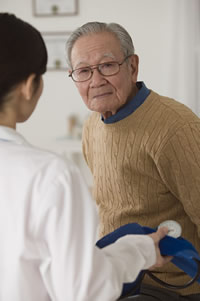Costs of Falls Among Older Adults
In 2000, falls among older adults cost the U.S. health care system over $19 billion dollars or $30 billion in 2010 dollars. With the population aging, both the number of falls and the costs to treat fall injuries are likely to increase.
How big is the problem?
- One in three adults age 65 and older falls each year.1,2
- Of those who fall, 20% to 30% suffer moderate to severe injuries that make it hard for them to get around or live independently, and increase their risk of early death.3
- Older adults are hospitalized for fall-related injuries five times more often than they are for injuries from other causes.3
- In 2009, emergency departments treated 2.4 million nonfatal fall injuries among older adults; more than 662,000 of these patients had to be hospitalized.4
How are costs calculated?
The costs of fall-related injuries are often shown in terms of direct costs.
- Direct costs are what patients and insurance companies pay for treating fall-related injuries. These costs include fees for hospital and nursing home care, doctors and other professional services, rehabilitation, community-based services, use of medical equipment, prescription drugs, changes made to the home, and insurance processing.5
- Direct costs do not account for the long-term effects of these injuries such as disability, dependence on others, lost time from work and household duties, and reduced quality of life.
How costly are fall-related injuries among older adults?

- In 2000, the total direct medical costs of all fall injuries for people 65 and older exceeded $19 billion: $0.2 billion for fatal falls, and $19 billion for nonfatal falls.6
- By 2020, the annual direct and indirect cost of fall injuries is expected to reach $54.9 billion (in 2007 dollars).5
- Among community-dwelling older adults, fall-related injury is one of the 20 most expensive medical conditions.7
- In 2002, about 22% of community-dwelling seniors reported falling in the previous year. Medicare costs per fall averaged between $9,113 and $13,507.8
- Among community-dwelling seniors treated for fall injuries, 65% of direct medical costs were for inpatient hospitalizations; 10% each for medical office visits and home health care, 8% for hospital outpatient visits, 7% for emergency room visits, and 1% each for prescription drugs and dental visits. About 78% of these costs were reimbursed by Medicare.7
- In a study of people age 72 and older, the average health care cost of a fall injury totaled $19,440, which included hospital, nursing home, emergency room, and home health care, but not doctors’ services.9
How do these costs break down?
Age and sex
- The costs of fall injuries increase rapidly with age.6
- In 2000, the costs of both fatal and nonfatal falls were higher for women than for men.10
- In 2000, medical costs for women, who comprised 58% of older adults, were two to three times higher than the costs for men.6
Type of injury and treatment setting
- In 2000, the direct medical cost of fatal fall injuries totaled $179 million. About 78% of fall deaths, and 79% of total costs, were due to traumatic brain injuries (TBI) and injuries to the lower extremities.6
- Injuries to internal organs were responsible for 28% of fall deaths and accounted for 29% of costs.6
- Fractures were both the most common and most costly nonfatal injuries. Just over one-third of nonfatal injuries were fractures, but these accounted for 61% of total nonfatal costs—or $12 billion.6
- Hospitalizations accounted for nearly two-thirds of the costs of nonfatal fall injuries and emergency department treatment accounted for 20%.6
- On average, the hospitalization cost for a fall injury is $17,500.10
- Hip fractures are the most frequent type of fall-related fracture. The average hospitalization cost was $18,000; this was 44% of the direct medical costs for hip fractures.11
References
- Hausdorff JM, Rios DA, Edelber HK. Gait variability and fall risk in community-living older adults: a 1-year prospective study. Archives of Physical Medicine and Rehabilitation 2001;82(8):1050–6.
- Hornbrook MC, Stevens VJ, Wingfield DJ, Hollis JF, Greenlick MR, Ory MG. Preventing falls among community-dwelling older persons: results from a randomized trial. The Gerontologist 1994:34(1):16–23.
- Alexander BH, Rivara FP, Wolf ME. The cost and frequency of hospitalization for fall-related injuries in older adults. American Journal of Public Health 1992;82(7):1020–3.
- Centers for Disease Control and Prevention, National Center for Injury Prevention and Control. Web–based Injury Statistics Query and Reporting System (WISQARS) [online]. Accessed November 30, 2010.
- Englander F, Hodson TJ, Terregrossa RA. Economic dimensions of slip and fall injuries. Journal of Forensic Science 1996;41(5):733–46.trial. The Gerontologist 1994;34(1):16–23.
- Stevens JA, Corso PS, Finkelstein EA, Miller TR. The costs of fatal and nonfatal falls among older adults. Injury Prevention 2006;12:290–5.
- Carroll NV, Slattum PW, Cox FM. The cost of falls among the community-dwelling elderly. Journal of Managed Care Pharmacy. 2005;11(4):307-16.
- Shumway-Cook A, Ciol MA, Hoffman J, Dudgeon BJ, Yorston K, Chan L. Falls in the Medicare population: incidence, associated factors, and impact on health care. Physical Therapy 2009.89(4):1-9.
- Rizzo JA, Friedkin R, Williams CS, Nabors J, Acampora D, Tinetti ME. Health care utilization and costs in a Medicare population by fall status. Medical Care 1998;36(8):1174–88.
- Roudsari BS, Ebel BE, Corso PS, Molinari, NM, Koepsell TD. The acute medical care costs of fall-related injuries among the U.S. older adults. Injury, Int J Care Injured 2005;36:1316-22.
- Barrett-Connor E. The economic and human costs of osteoporotic fracture. American Journal of Medicine 1995;98(suppl 2A):2A–3S to 2A–8S.
Contact Us:
- Centers for Disease Control and Prevention
National Center for Injury Prevention and Control (NCIPC)
4770 Buford Hwy, NE
MS F-63
Atlanta, GA 30341-3717 - 800-CDC-INFO
(800-232-4636)
TTY: (888) 232-6348
New Hours of Operation:
8am-8pm ET/
Monday-Friday
Closed Holidays - cdcinfo@cdc.gov



